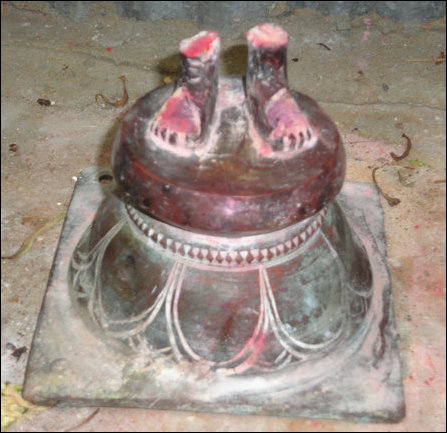Unique temple of Tamil folk heritage found destroyed, desecrated in HSZ in Jaffna
 [TamilNet, Wednesday, 30 May 2012, 05:25 GMT]
[TamilNet, Wednesday, 30 May 2012, 05:25 GMT]
A unique temple of Eezham Tamil folk heritage, dedicated to Kooddaththaar, a deity historically worshipped by a soldier guild that got absorbed into the toddy-tapping community, was found destroyed in bombing and its rare bronze idol sawed off and stolen at the Vasanthapuram locality of I’lavaalai in Jaffna. For the last two decades the locality was under the ‘High Security Zone’ (HSZ) of the occupying Sinhala military. Recently, when some fringes of the HSZ were allowed for resettlement, the people of Vasanthapuram returned. Finding their temple destroyed and the deity missing they now worship only the pedestal remaining. Vasanthapuram is where the occupying military has built lines of a few monotype houses for the resettled people and often shows them off to visiting foreign dignitaries as an example of its ‘reconciliation’ efforts.

The rare bronze image of the deity Kooddaththaar found sawed off in the Sinhala Army-occupied ‘High Security Zone’ at I'lavaalai in Jaffna. The image of the collective deity of the Tamil guild of soldiers of the ancient times, was in anthropomorphic form. Note that despite the idol missing, the local Tamil devotees have applied saffron in reverence to the the remaining part. [Image courtesy: History Department, University of Jaffna]

Destroyed and delapidated walls of the Kooddaththaar Temple in the Sri Lanka occupied ‘High Security Zone’ at I'lavaalai [Image courtesy: History Department, University of Jaffna]

Mr Naakan, caretaker and folk-priest (Poochaari) of the Kooddaththaar Temple at I'lavaalai, Jaffna [Image courtesy: History Department, University of Jaffna]
Writing a feature in Virakesari on Sunday, Professor Pushparatnam elucidated on the historical, religious and social significance behind the heritage of the temple.
Bringing out the present conditions in the locality, he said that areas interior to the main roads are beyond recognition with scrub jungle and ruined buildings.
He records an interesting observation that the emotional priority of the resettled people is to first rebuild their temples than to rebuild their houses.
Noting that the coral-stone-built Kooddaththaar temple was one of the many structures destroyed in bombing during the war, and noting that besides the main bronze image there were also other images missing from the temple, Pushparatnam says, people have now placed stones to represent the various other deities and worship them.
The bronze image of the deity Kooddaththaar was in anthropomorphic form with just two hands wielding weapons, Pushparatnam cited an old-generation person earlier associated with the temple.
In explaining the cult of Kooddaththaar, Pushparatnam cited Dr. P. Ragupathy assigning it to the hero-worship cult of the soldier guilds.
When contacted by TamilNet, Dr. Ragupathy said Kooddaththaar, A’n’namaar, Cheavukar and Padaikkalar found in the folk religion of Eezham Tamils are deities of collective hero-worship, originating from the soldier guilds of historical times. The collectiveness in the concept could be seen in the plural form used for the names of the deities: Kooddaththaar (members of the guild), A’n’namaar (from A’n’nalmaar, meaning leaders or those who have become gods), Cheavukar (soldiers), Padaikkalar (those who wield weapons), he pointed out. Collectiveness of a community personified into a deity is an alternative idea of religion found only at folk levels, he further said.
The soldier guilds, associated with the protection of trade guilds and rulers of the past, were also cultivators or craftsmen in peacetimes. In the medieval times, especially in the late medieval times, they were also hired and migrated to far and wide places in South and Southeast Asia. With the collapse of native trade and state institutions, the soldier guilds were absorbed into various castes and professions.


